What's new at Scion Edition No. 3
Kia ora and welcome to the latest issue of What’s new at Scion.
This is the third issue of our newsletter written specifically with you, the forestry industry, in mind. It’s all about highlighting our research that will provide real impact within your business and sector.
In this edition, find out about:
We know the sector is facing challenges and Scion wants to hear from and work with industry to address these challenges. Please reach out to the key contact person in each story for further information and discussion or connect with me directly.
Henri Bailleres, General Manager Forests to Timber Products

Forest Health Diagnostics Service
Scion's Forest Health Diagnostics service provides professional identification of pests and diseases that threaten forestry assets, enabling early detection and effective management to minimise economic losses and maintain forest productivity.
The service is designed to assist forest owners, managers, and stakeholders in identifying potential biosecurity risks. Scion's team of experts uses advanced diagnostic tools and up-to-date scientific knowledge to accurately identify pathogens and pest species. This allows forest managers to make informed decisions about appropriate control measures and prevent widespread damage.
By leveraging Scion's Forest Health Diagnostics, companies can safeguard their forestry investments, reduce the spread of harmful organisms, and contribute to the sustainability of New Zealand’s forest industry. Fast, reliable, and scientifically robust, this service plays a key role in protecting the future of the forestry sector.
Contact the Forest Health Diagnostics team for more details.

Satellite sensing of under canopy soil moisture – a new approach for forest managers
Soils are essential in supplying water to plants, especially in summer. The dynamics of forest soil moisture is not well understood. As parts of New Zealand get hotter and drier under climate change, knowing where soils are that have low water availability can be useful for climate change planning.
Using new satellite remote sensing technologies provides cheaper, finer resolution and dynamic soil moisture measurements throughout the year. By taking cutting-edge science developed by the Forest Flows programme, Scion researchers have developed practical applications that could be used by forest managers for stand management, cost-effective soil mapping, and assessing the risk to climate change.
This approach is not restricted to the forestry sector. It can be readily applied to native forests and other land uses.
Contact Dean Meason for more details.

Battle with the beetles: Alternative insecticide to control Paropsis for eucalypts
The Eucalyptus tortoise beetle, Paropsis charybdis, is devastating a range of eucalyptus species including Eucalyptus nitens via defoliation, leaving trees with reduced growth and poor form. There are 15,300 hectares of vulnerable E. nitens plantations in New Zealand and the potential yield loss due to damage from this beetle is estimated at $10 million per year.
Currently, the Paropsis beetle (larvae and adults) have been controlled by aerially applying alpha-cypermethrin, an effective but non-specific control. The research is funded by AGMARDT, Oji Fibre Solutions and Scion to develop more environmentally friendly organic insecticides.
An alternative less ecotoxic, naturally-derived insecticide has been identified with efficacy against each life stage of Paropsis charybdis. Two cost effective formulations and application methodology, employing the alternative naturally-derived insecticide have been developed and an opportunity has been identified to partner with Corteva Agriscience NZ Ltd to enable industry access.
Eucalypt growers will soon have the option to transition to the less ecotoxic insecticide alternative. Some foresters have already begun field trials, and the chemical supplier plans to undertake the EPA regulatory process required to register this product for Paropsis charybdis control in New Zealand eucalypt plantations.
Contact Justin Nairn for more details.

Exploring using UAVs for spot spraying
Scion has been involved with pest incursion responses and field research in aerial spray methodology for decades looking for new, more targeted ways to tackle pest and insect outbreaks.
Recent work explored improving the effectiveness of unmanned aerial vehicles (UAVs) for spot spraying during biosecurity incursions, making pest control more targeted, safer and less invasive.
A two-year research project, funded by B3 (Better Border Biosecurity) and led by Scion’s Plant Protection Physics and Chemistry team lead Dr Justin Nairn, identified a low-drift alternative spray method to improve spot spraying in higher wind conditions. The method involves using a larger, but less concentrated droplet reducing off-target drift.
With historic reluctance to spray insecticides in urban environments, producing less off-target effects will improve license to operate in these areas. Ultimately the work improves target accuracy, reduces drift and widens suitable operational wind thresholds all while adding a new tool to the biosecurity toolbox.
As a result of the work, unmanned aerial vehicle sprayers will be optimised and adopted for biosecurity incursion responses where spot spraying is an option.
In aligned research Scion social scientist Dr Andrea Grant explored the social and cultural considerations of UAV spraying including public perception, social issues, and safety and ethics.
- Read our media release: UAVs for pest control take off.
Contact Justin Nairn for more information.

Cutting-Edge Remote Sensing for Smarter Forest Management
Rayonier Matariki Forests (RMF) is exploring innovative solutions to improve understanding of the efficacy of their chemical thinning operations. In collaboration with Scion, and with co-funding from Forest Growers Research, this research aims to harness advanced remote sensing technologies—specifically hyperspectral and thermal imaging—to detect herbicide-treated trees before visual signs of stress appear.
The study will use UAVs equipped with high-resolution hyperspectral and thermal sensors to capture data over staggered herbicide treatments that have seven-day intervals. This approach creates a time series that will allow researchers to monitor how plant stress develops and predict herbicide efficacy. Hyperspectral sensors measure detailed light wavelengths reflected by plants, which can indicate changes in plant health, while thermal sensors detect temperature variations caused by stress-induced disruptions to a plant’s water and temperature regulation. By combining these technologies, the research hopes to characterise early indicators of herbicide efficacy, and potentially offer RMF and industry a more precise and cost-effective way to manage thinning, potentially reducing follow-up treatments and optimising resource use. The study could also have wider implications for the early detection of disease and/or drought stress.
In addition, the project aims to assess whether these results can be replicated using more affordable, industry-grade sensors, such as multi-spectral cameras. This would inform the broader forestry industry about scalable, cost-effective solutions for detecting and monitoring tree stress. The findings could lead to optimised resource allocation, cost savings, and more efficient, data-driven forest management practises.
Contact Russell Main for details.

Partner or perish: Tree microbiomes and climate change
The Tree Root Microbiome Programme is using Pinus radiata as a model to understand how trees and their microbiomes can work together to resist the negative effects of climate change. The long-term goal of the research is to develop a microbiome that can be managed to increase forest productivity and resilience, while also driving positive changes to tree physiology and wood formation. This programme is an important part of Scion’s efforts to ensure our forests not only survive, but thrive in the predicted future climate.
An article outlining the underlying concepts of this research, led by Scion’s Sarah Addison, was recently published in Trends in Plant Science. Titled Partner or perish: tree microbiomes and climate change, it reviews the current knowledge regarding the complex relationships between plants and their microbiome, staking out new areas for research to harness the beneficial properties of microbes. The publication of this work in one of the leading plant science journals in the world provides evidence that the Tree Root Microbiome Programme is at the leading edge of international research in this field.
The paper involved researchers from Scion, Wright State University (Ohio) and the Hawkesbury Institute for the Environment at Western Sydney University where Addison is also undertaking a PhD.
- Read the media release: Paper helping to shape the trajectory of global plant science research
For more information, contact Sarah Addison.
